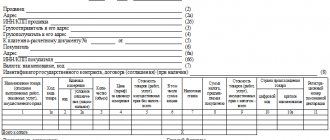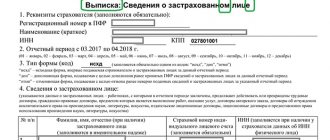Prepayment invoice
Return to Prepayment
An advance payment invoice is a document intended for payment (prepayment) for a product or service. An advance payment invoice is an important document for both the seller and the buyer.
The invoice form for payment does not have a unified form, therefore the main requirement for the form (form) for prepayment is to reflect in the form the basic details necessary to document the fact of the sale of goods or services.
The prepayment invoice is not a unified form and can be issued in any way. The invoice must indicate the goods and the seller's payment details sufficient to transfer payment.
Indicate the date the invoice was issued and its number.
When is an advance invoice issued? Sample filling
The invoice number for prepayment can be anything, if the company does not have a similar numbering procedure. The account may also not have a number. The account can be valid for a certain time or be indefinite. Write down this requirement when completing it.
Include in the invoice the necessary information about the product for which you are paying. Indicate the price per unit of goods and the units of measurement of the products sold (pieces, units of weight or volume). Enter the quantity of products to be paid and the total invoice amount. Please indicate the final amount in words.
Write down in detail the payment details on the invoice to which payment should be transferred. An error in one character may cause the bank to return a payment order.
Include contact information in the invoice so that the payer has the opportunity to clarify all unclear points at the stage of creating the payment document. If clarifications and clarifications are required by the bank to process the payment, the request may take up to five business days.
Include a reminder on your invoice to provide a power of attorney upon receipt of the item. Indicate information about the place of receipt of the paid goods and information about the employee responsible for shipment.
The invoice for prepayment must be signed by the head of the organization distributing the goods. Signing by an authorized employee is possible. The signature is certified by the seal of the organization.
In a large trading organization, the creation of an invoice for prepayment begins the chain of movement of goods and document flow. The account number can be included in the document flow system and be the number/personal account of the buyer/client. The date the invoice is issued serves as the beginning of the countdown for reserving goods in the warehouse.
If a trading organization has a bonus program for customers, the invoice may specify the conditions for the accumulation and application of bonuses.
https://youtu.be/o79PIa9ks7w
DELIVERY AGREEMENT
with the condition of prepayment for the supplied goods
G.
"" 2020
in a person acting on the basis, hereinafter referred to as “ Supplier
", on the one hand, and in the person acting on the basis, hereinafter referred to as the "
Buyer
", on the other hand, hereinafter referred to as the "Parties", have entered into this agreement, hereinafter the "
Agreement
", as follows:
SUBJECT OF THE AGREEMENT
1.1. In accordance with this Agreement, the Supplier undertakes to deliver the Goods to the Buyer in accordance with the Specification (Appendices No. 1, which are an integral part of this agreement), and the Buyer undertakes to accept and pay for it.
1.2. The name, assortment, quantity, price of the goods, delivery times are agreed upon by the Parties and are determined in the Specifications (Appendices), which are an integral part of the Agreement.
2.
PRICE AND AMOUNT OF THE AGREEMENT
2.1. The Goods supplied under the Contract are paid for at the price agreed upon by the parties in accordance with the Specifications (Appendices) and the tender protocol.
2.2. The total amount of the contract is determined as the total cost of all Goods delivered to the Buyer in accordance with the Specifications (Appendices) for the entire period of validity of the Contract.
2.3. The price for the goods is set in rubles and includes VAT-18%, other taxes and fees, cost of packaging, packaging, labeling and delivery to the Buyer’s warehouse.
PAYMENT PROCEDURE
3.1. Payments for the Goods are made on the condition of % prepayment within banking days from the date of issuing the invoice for payment by transferring funds to the Supplier's bank account. Final payment within working days from the moment of signing the delivery note (transfer and acceptance certificates).
3.2. The moment of payment is the receipt of funds to the Supplier's bank account.
3.3. If the Goods are shipped by the Supplier to the Buyer before making an advance payment, then payment for the delivered Goods is made by the Buyer within banking days from the date of issuance of the invoice by the Supplier.
DELIVERY ORDER
4.1. The method and terms of delivery are agreed upon by the Parties and are determined in the Specifications (Appendices) to the Agreement.
4.2. The Buyer undertakes to take all appropriate measures to ensure acceptance of the Goods delivered by the Supplier in accordance with the terms of the Agreement, both directly to the Buyer and to the addresses of the recipients specified by the Buyer in the application.
4.3. Upon receipt of the delivered Goods from the carrier, the Buyer or the recipient, on his behalf, undertakes to check the compliance of the Goods with the information specified in the shipping documents, as well as to accept these Goods from the carrier in compliance with the procedure and rules provided for by the regulatory documents governing the activities of the carrier.
4.4. The delivery date is the date of receipt of the Goods by the Buyer, recorded by a mark in the delivery note.
4.5. Ownership of the Product, as well as the risk of its accidental destruction, deterioration, loss, damage passes to the Buyer from the moment of its receipt in accordance with the invoices.
QUALITY AND COMPLETENESS
5.1. The quality of the supplied Goods must comply with the specifications and GOSTs approved by the legislation of the Russian Federation.
5.2. Acceptance of the Goods in terms of quantity and quality is carried out in accordance with the instructions for the acceptance of products in terms of quality and quantity, approved by the Resolutions of the USSR Civil Code dated 06/15/65 No. P-6 and dated 04/25/66 No. P-7, and acceptance of the 5th VP of the Ministry of Defense of the Russian Federation.
5.3. In the event of a discrepancy between the Goods in terms of quantity and quality, a call to the Supplier's representative is required within hours from the date of receipt of the Goods by the Buyer.
5.4. If the Supplier's representative fails to appear, the Buyer accepts the Goods independently, drawing up a report on the established discrepancies in quantity and quality upon acceptance of the Goods.
5.5. If the call of the Supplier's representative turns out to be unfounded, the expenses incurred by the Supplier in connection with the visit to the Buyer will be reimbursed by the latter.
RESPONSIBILITY OF THE PARTIES
6.1. The obligations of the parties must be fulfilled properly, on time and in accordance with this Agreement and current legislation.
6.2. A Party to the Agreement whose property interests are violated as a result of non-fulfillment or improper fulfillment of obligations under the Agreement by the other Party has the right to demand full compensation for losses caused to it.
6.3. For failure to fulfill or improper fulfillment of the terms of the Agreement, the Parties are liable in accordance with the current civil legislation.
6.4. A party that has not fulfilled or improperly fulfilled its obligations under the Agreement while fulfilling its terms shall be liable unless it proves that proper fulfillment of obligations was impossible due to force majeure (force majeure), that is, extraordinary and unavoidable circumstances, under specific conditions specifically period of time. The Parties to this Agreement included the following as force majeure circumstances: natural phenomena (earthquake, flood, lightning strike, volcanic eruption, mudflows, landslide, tsunami, etc.), temperature, wind force and precipitation level at the place of fulfillment of obligations under the Agreement, excluding normal life activities for a person; moratorium of authorities and management; strikes organized in accordance with the procedure established by law and other circumstances that may be determined by the Parties to the Agreement as force majeure for the proper fulfillment of obligations.
SETTLEMENT OF DISPUTES
7.1. The parties will strive to resolve all disputes that may arise during the execution of the terms of the Agreement through negotiations, exchange of letters, clarification of the terms of the agreement, drawing up the necessary protocols, additions and changes, exchange of telegrams, faxes, etc.
7.2. If it is impossible to resolve disagreements through negotiations, they are subject to judicial review at the location of the defendant.
OTHER CONDITIONS
8.1. This agreement is a standard agreement, any changes to this agreement are made only by the Buyer; if you disagree with any terms of the agreement, the Supplier draws up a protocol of disagreements.
8.2. All changes and additions to this Agreement are made in writing and are an integral part of this Agreement.
Rules for filling out the document: step-by-step instructions
First, let's fill in the rows , they are located in front of the tabular part:
- Line No. 1 - serial number (taken from the list of documents), date.
- Line 2, 2a, 2b – location and details of the seller.
- Line 4 – write the location of the final recipient, if the final addressee is also a consumer of the product, then put a dash.
- Line 5 - here we write the number and date of the document. When issuing an invoice based on several payments at once, all payments without exception are indicated. If the advance payment for the goods was not made in cash, only then a dash is added in column 5. Thus, an invoice can be issued only upon receipt of payment.
- Line 6, 6a, 6b - location and details of the buyer.
- Line 7 is the code of the monetary unit, if it is the ruble, then 643.
- Line 8 – suppliers under a government contract show the code of such an agreement.
Now let's start filling out the tabular part of the form. In this part of the form, only sections 1, 7, 8 and 9 are filled out, and dashes are added in the others.
- Column 1 must indicate:
- Product Name;
presentation of work performed, services provided, property rights.
- Columns 2, 3, 4 (unit of measurement, number, price per piece of measurement) do not need to be filled out. In addition, the data in columns 10 and 11 (country of origin of the goods, customs declaration number) is not indicated. They need to have dashes. When calculating VAT specifically on the prepayment amount, the estimated tax amount is used.
- Section 7 - indicates the estimated tax rate . It is possible to make a note in the act, say, accepted from such and such.
Will it be possible to write the phrase “Advance payment” instead of the product name? In another column, it is possible to write the phrase “Advance payment under the agreement...” without providing the name of the goods (works, services). Such wording in an “advance” invoice is quite possible. In such a case, in column 1 we advise you to write the phrase “Advance payment for... (name of the product is required) under the contract...”.
If the seller clearly understands for which goods (works, services) payment was received from the consumer, it is possible to indicate their direct names in column 1 of the invoice. In this case, it is necessary to make an integral note that the amount of tax is calculated directly from the amount of the purchased prepayment.
The completed form must be signed by the head of the company and its chief accountant , or in the absence of the latter, the responsible person.
You will find a detailed procedure for filling out the ASF here.
Tip 1: How to issue an invoice for prepayment
This Agreement comes into force from the date of its signing by the parties and is valid in terms of mutual settlements until they are fully executed.
8.4. The Agreement may be terminated early by agreement of the parties, as well as at the request of one of the Parties in the event of violation by the other party of the obligations provided for in the Agreement.
8.5. If one of the parties changes its legal address, name, bank details, etc., it is obliged to notify the other party in writing within days.
8.6. A facsimile copy of the Agreement and its annexes have equal legal force until the original documents are submitted.
8.7. This Agreement is drawn up and signed in two copies having equal legal force, one copy for each of the parties.
LEGAL ADDRESSES AND BANK DETAILS OF THE PARTIES
Provider
Legal address: Postal address: Taxpayer Identification Number: KPP: Bank: Account/account: Correspondent/account: BIC:
Buyer
Legal address: Postal address: Taxpayer Identification Number: KPP: Bank: Account/account: Correspondent/account: BIC:
SIGNATURES OF THE PARTIES
Provider _________________
Buyer _________________
Home ›› Printable forms ›› Prepayment invoice
Seller mistakes
When issuing advance invoices
No later than five calendar days from the date of receipt of the advance payment, the supplier must provide the buyer with VAT. The invoice is drawn up in two copies: one is given to the buyer, and the second is registered in the sales book (clause 3 of article 168 of the Tax Code of the Russian Federation). When deciding whether to issue an invoice, accountants make mistakes in two cases.
- When the same buyer (customer) repeatedly transfers prepayment amounts for one or more transactions during a tax period, a single invoice is issued at the end of the month (quarter), which is illegal in such a situation. For each amount received, an invoice must be issued within the specified deadline.
- Let's say that during the quarter you received an advance payment, and then in the same quarter you shipped the goods (transferred work, services). More than five days passed between prepayment and shipment. You must first issue an advance invoice, and then an invoice for the sale of prepaid goods (works, services). This is required by the provisions of paragraph. 2 clause 1, clause 3 art. 168, paragraph 3 of Art. 169 of the Tax Code of the Russian Federation, if there are no circumstances provided for in paragraph. 3 clause 17 of the Rules for maintaining purchase books (hereinafter in the article we refer to the Rules for maintaining purchase books and sales books, filling out invoices, approved by Decree of the Government of the Russian Federation No. 1137 of December 26, 2011).
The Ministry of Finance allows you not to issue an invoice if you received an advance payment for an upcoming delivery and, within five calendar days from the date of receipt, shipped the goods, performed the work, provided the service (letters dated October 12, 2011 No. 03-07-14/99, dated 03/06/2009 No. 03-07-15/39, clause 1). However, we still recommend that in this case, issue two invoices: both for the amount of the prepayment received and for shipment. Since this is the opinion of the Federal Tax Service, and it is this agency that will check your declaration (letters dated March 10, 2011 No. KE-4-3/3790, dated February 15, 2011 No. KE-3-3/ [email protected] ).
Please note that in order to deduct VAT paid on an advance payment, the seller must register an advance invoice in the purchase book, which was previously reflected in the sales book (clause 22 of the Rules for maintaining the purchase book). Thus, an advance invoice is the basis for a deduction not only from the buyer, but also from the seller (clause 1 of Article 169, clause 9 of Article 172 of the Tax Code of the Russian Federation).
Recommendations for the application of Art. 54.1 of the Tax Code of the Russian Federation, nuances of due diligence. See the analysis of these and other topics in the recordings of Kontur.Conference-2018.
In the details of advance invoices
Errors that the seller (supplier) makes when filling out the details in the advance invoice can be critical for the buyer if he decides to exercise the right to deduction (clauses 1 and 5–6 of Article 169 of the Tax Code of the Russian Federation). In the advance invoice, as in a regular one, the following details must be filled in (clause 5.1 of Article 169 of the Tax Code of the Russian Federation):
- serial number of the invoice, while advance invoices are numbered in general chronological order with shipping invoices (letter of the Ministry of Finance dated October 16, 2012 No. 03-07-11/427);
- invoice date;
- name, address, INN and KPP of the seller and buyer in accordance with the constituent documents. You can indicate both full and abbreviated names.
In addition, advance invoices must include:
- on line 5: number and date of the payment document for which the advance was received. If the advance was received in non-monetary form, a dash is added. Since the tax authorities conduct cross-checks of accruals and deductions, it is important that both the buyer and the seller correctly indicate this detail in the books of purchases and sales;
- on line 7: name and code of the currency in which the advance was received (according to OKV). If the price is determined in foreign currency (cu), but payment is made in rubles, indicate the name of the currency “Russian ruble” and its code “643” (letter of the Federal Tax Service dated July 21, 2015 No. ED-4-3/12813).
Prepayment invoice (sample)
The Expredo program allows you to create forms for prepayment, and this is done in literally a couple of seconds - download the program and see for yourself.
"Expredo" is a successful solution for your business:
In the program you can easily and quickly create an invoice for prepayment and download it. The Expredo program allows you to store in its database an unlimited number of previously issued prepayment invoices. You can always return to your data at any time without having to re-enter the information.
Are you out of the office? And you urgently need to issue or download an invoice for prepayment?
- it's simple: the portable version of the Expredo program will help you. You just need to use the portable version of the Expredo program to issue an invoice form for prepayment, installed on any removable media (disk, flash drive, etc.), the Expredo program has a small distribution size (3 MB).
The image shows a sample invoice form for prepayment.
Examples of printed forms sold in Expredo
Advance with subsequent final payment
Example 30. A trading company entered into a purchase and sale agreement for the purchase of a batch of telephone sets in the amount of 118,000 rubles, including VAT 18% - 18,000 rubles. The transfer of goods must be made within five working days from the date of receipt of the advance payment (50% of the contract value of the goods) into the supplier’s bank account. Ownership passes when the goods are transferred to the supplier's warehouse. Final payment for the goods is made within five working days after its delivery.
On January 24, the trading enterprise transferred funds in the amount of 59,000 rubles to the supplier as payment under the contract, including VAT 18% - 9,000 rubles. On the same day they were credited to the supplier's bank account.
On January 26, the supplier handed over to the representative of the trading enterprise a consignment of goods worth 118,000 rubles, including VAT 18% - 18,000 rubles.
In the accounting records of the enterprise, this operation will be reflected as follows:
Debit 60 subaccount “Settlements on advances issued” Credit 51
— 59,000 rub. — on the date of debiting funds from the current account, the advance amount in the amount of 50% of the cost of the goods is reflected;
Debit 41 Credit 60
— 100,000 rub. — at the time of transfer of ownership, the acceptance of goods for accounting is reflected;
Debit 19 Credit 60
— 18,000 rub. — on the basis of settlement documents, the amount of VAT is allocated;
Debit 60 Credit 60 subaccount “Settlements for advances issued”
— 59,000 rub. — at the time of acceptance of goods for accounting, the previously transferred advance payment is credited;
Debit 60 Credit 51
— 59,000 rub. — on the date of debiting funds from the current account, the transfer of debt for goods is reflected.
Under an agreement for the sale of goods on credit, payment for the goods is made after its transfer to the buyer.
Payment can be made in a lump sum or in installments.
In the first case, the loan is provided on deferred payment terms. The debt is repaid in a lump sum on a date established by agreement of the parties, or after a certain period. If the condition for the period for which a deferred payment is granted is not provided for in the contract, payment must be made within the period provided for in Art. 314 Civil Code of the Russian Federation.
According to Art. 314 of the Civil Code of the Russian Federation, in cases where the obligation does not provide for a deadline for its fulfillment and does not contain conditions allowing to determine this period, it must be fulfilled within a reasonable time after the obligation arises.
An obligation that is not fulfilled within a reasonable time, as well as an obligation whose execution period is determined by the moment of demand, the debtor is obliged to fulfill within seven days from the date the creditor presents a demand for its fulfillment, unless the obligation to perform within a different period follows from the law, other legal acts, conditions obligations, customs of business or the substance of the obligation.
If payment for goods is made in installments, this means that the loan is provided in installments. The debt will be repaid in installments within certain periods agreed upon in the contract. In accordance with Art.
In what cases is it required?
It is known that an invoice is issued for a specific advance payment . Many accountants issue an invoice for the prepayment made directly in the accounting program. However, it is printed only at the request of the consumer. They feel much calmer this way. Then they strictly comply with all the requirements of the Tax Code.
Read about in what cases and when an advance invoice is issued here.
If there is an agreement
At the time of receipt of goods directly subject to VAT at various rates (10% or 18%) on account of the completed shipment, the procedure for filling out column No. 1 of the invoice depends on the terms of the existing agreement. And if the data contained in the contract makes it possible to divide the volumes, as well as the cost of goods directly subject to VAT, they will need to be separated into separate items in the invoice.
If such a distribution is unrealistic, indicate in the invoice the direct name of the goods , and also the VAT rate of 18/118. At the time of issuing an invoice for prepayment (incomplete payment) under contracts that take into account various delivery times for goods, the funds for the advance payment (incomplete payment) are not required to be divided.
If there is no contract
An invoice must be issued for prepayment, even if an agreement with the consumer has not been concluded or if the agreement does not require the transfer of an advance payment. Whenever funds are received related to further supplies of goods, the seller is obliged to generate an invoice and present it to the buyer.
Otherwise, the seller may be held liable for taxation for severe non-compliance with the laws of accounting for profits and objects of taxation, which led to a direct understatement of the tax base. The direct buyer, if there is no provision in the contract for the direct transfer of the advance payment, the seller will need to prove in court his right to tax deduction of VAT from the advance invoice.
How to reflect prepayment in invoice sample
489 of the Civil Code of the Russian Federation, in contracts for the sale of goods with installment payment, it is necessary to indicate the price of the goods, the procedure, terms and amounts of payments for it.
The legislator provided the seller of goods with the opportunity to limit the buyer’s rights to dispose of property purchased on credit. According to paragraph 5 of Art. 488 of the Civil Code of the Russian Federation, unless otherwise provided by the purchase and sale agreement, from the moment the goods are transferred to the buyer and until payment, goods sold on credit are recognized as being pledged by the seller to ensure the buyer fulfills his obligation to pay. It is appropriate to remember that if a product needs to be “pledged”, the ownership of it must already pass from the seller to the buyer.
Go to page: 1
2
Advance payment (advance payment) - payment by the buyer (customer) for goods (work, services) before their delivery (performance).
Advance payment is also called advance payment or prepayment.
Example
Under the purchase and sale agreement, the parties agreed that the buyer pays an advance payment in the amount of 50% of the cost of the goods. The balance is due within 10 days after receiving the goods.
The term “advance” in English is prepayment; advance payment.
Features of prepayment recording
- When issuing invoices, either the name itself or the general name of a group of goods is written in the column “name of the product...”, without requiring advance payment, contracts, or invoices.
- In column No. 1, the name of the goods must correspond to the name confirmed in the agreement for the supply of goods. If such a name is general (for example, petroleum products, confectionery products). In addition to the name of the goods, the invoice must indicate the details of the agreement for the fulfillment of which an advance (partial payment) was received.
- The “prepayment” entry in the advance invoice is created automatically.
If there is no data for advance invoices, then proceed differently . Individual entrepreneurs often have conditions that do not fall under a single procedure. Let us analyze special cases associated with the registration of a business transaction.
This will make it possible to understand how to deal with the account directly in the purchase book. To record actions and control them, these documents are recorded in a special journal specialized for account registration.











